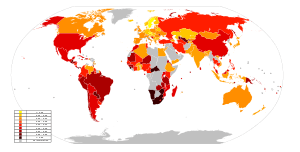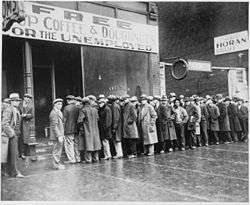Basic income in the United States
A basic income (also called unconditional basic income, basic income guarantee, universal basic income or universal demogrant[1]) is a form of social security[2] in which all citizens or residents of a country regularly receive an unconditional sum of money, either from a government or some other public institution, in addition to any income received from elsewhere.
Basic income can be considered as another human right since assure that every citizen of a country have basic human rights and needs covers; right to life, right to food, right to water, right to clothing, right to housing, right to education, right to an adequate standard of living, right to health, right to social security, right to legal aid, welfare rights, right to science and culture, etc.
Basic income systems that are financed by the profits of publicly owned enterprises (often called social dividend or citizen's dividend) are major components in many proposed models of market socialism.[3] Basic income schemes have also been promoted within the context of capitalist systems, where they would be financed through various forms of taxation.[4]
Similar proposals for "capital grants provided at the age of majority" date to Thomas Paine's Agrarian Justice of 1795, there paired with asset-based egalitarianism. The phrase "social dividend" was commonly used as a synonym for basic income in the English-speaking world before 1986, after which the phrase "basic income" gained widespread currency.[5] Prominent advocates of the concept include Philippe Van Parijs, Ailsa McKay,[6] André Gorz, Hillel Steiner, Peter Vallentyne, and Guy Standing.
Benefits

A basic income frees people from doing tedious or illegal work to cover part or all of their basic living expenses.
Extreme poverty in America has more than doubled since 1996 and more than 1.5 million American Households live on less than $2 a day.[7][8][9][10][11][12] Basic income is a economic tool to reverse that inequality.
History

During the 1960s there was a big debate in the United States regarding poverty and how to deal with it. One of the solutions that came up during this time was basic income, mostly in the form of a negative income tax.
In 1968, James Tobin, Paul Samuelson, John Kenneth Galbraith and another 1,200 economists signed a document calling for the US Congress to introduce in that year a system of income guarantees and supplements.[13] Martin Luther King, a famous civil rights activist and politician, also gave his support for the idea in his book Where Do We Go From Here: Chaos or Community?, published in 1967.[14][15] In 1969, Richard Nixon proposed a "Family Assistance Program" which resembled guaranteed income, in that benefits did not rapidly taper with additional earnings by the beneficiaries. Nixon's proposal only applied to families, but extended previous welfare by benefiting more than those without a 'father'.[16]
Other advocates from the 1960s and 1970s include Senator George McGovern who called for a 'demogrant' that was similar to a basic income and Mike Gravel who talked about a tax rebate paid in a monthly check from the government to all citizens as part of a transition away from income taxes and toward a pre-bated national sales tax (the FairTax).[17][18] Libertarian advocates include Milton Friedman[19] and Charles Murray.[20] Also worth mentioning is Jeremy Rifkin, who in his book The End of Work, argued that there may be an increasing need for such measures as automation would reduce the demand for workers in future.[21]
Welfare rights in the United States
The Flemming Rule of 1960, named after Arthur Flemming, was an administrative ruling which decreed that states could not deny income assistance eligibility through the Aid to Families with Dependent Children program on the basis of a home being considered unsuitable per the woman's children being termed as illegitimate.
In 1963 Johnnie Tillmon founded ANC (Aid to Needy Children) Mothers Anonymous, which was one of the first grassroots welfare mothers’ organizations, and which eventually became part of the National Welfare Rights Organization.[22]
The National Welfare Rights Organization, active from 1966 to 1975, was an activist organization that fought for the welfare rights of people, especially women and children. The organization had four goals: adequate income, dignity, justice, and democratic participation. Johnnie Tillmon was the first chair of the organization.[23]
King v. Smith, 392 U.S. 309 (1968), was a decision in which the Supreme Court held that Aid to Families with Dependent Children could not be withheld because of the presence of a "substitute father" who visited a family on weekends.
In April 1991 Cheri Honkala founded the Kensington Welfare Rights Union, a progressive social justice, political action, and advocacy group of, by, and for the poor and homeless which is operating out of Philadelphia, Pennsylvania and led by Galen Tyler.
Basic income in Alaska
The Alaska Permanent Fund is a constitutionally established permanent fund managed by a state-owned corporation, the Alaska Permanent Fund Corporation (APFC).[24] The fund was established in Alaska in 1976[25] by Article 9, Section 15 of the Alaska State Constitution[26] under Governor Jay Hammond. From February 1976 until April 1980, the Department of Revenue Treasury Division managed the state's Permanent Fund assets, until, in 1980, the Alaska State Legislature created the APFC.[27]
Shortly after the oil from Alaska’s North Slope began flowing to market through the Trans-Alaska Pipeline System, the Permanent Fund was created by an amendment to the Alaska Constitution. It was designed to be an investment where at least 25% of the oil money would be put into a dedicated fund for future generations, who would no longer have oil as a resource.[28] This does not mean the fund is solely funded by oil revenue.
The Fund includes neither property taxes on oil company property nor income tax from oil corporations, so the minimum 25% deposit is closer to 11% if those sources were also considered.[Context?] The Alaska Permanent Fund sets aside a certain share of oil revenues to continue benefiting current and all future generations of Alaskans. Many citizens also believed that the legislature too quickly and too inefficiently spent the $900 million bonus the state got in 1969 after leasing out the oil fields. This belief spurred a desire to put some oil revenues out of direct political control.
The Alaska Permanent Fund Corporation manages the assets of both the Permanent Fund and other state investments, but spending Fund income is up to the Legislature. The Corporation is to manage for maximum prudent return, and not—as some Alaskans at first wanted—as a development bank for in-state projects. The Fund grew from an initial investment of $734,000 in 1977 to approximately $53.7 billion as of July 9, 2015.[29] Some growth was due to good management, some to inflationary re-investment, and some via legislative decisions to deposit extra income during boom years. Each year, the fund's realized earnings are split between inflation-proofing, operating expenses, and the annual Permanent Fund Dividend.
Basic income in the 21st century
United States politicians are discussing the benefits of an American Basic Income, but there is not a consensus about the benefit of this issue.
The Green Party of the United States in its 2010 platform advocated for a universal basic income to "every adult regardless of health, employment, or marital status, in order to minimize government bureaucracy and intrusiveness into people's lives."[30]
See also
- Basic income
- List of jobs in United States by average wage
- Income inequality in the United States
- Poverty in the United States
- Hunger in the United States
- Homelessness in the United States
- Social programs in the United States
- Economic inequality
- Extreme poverty
- Soup kitchen
- Educational attainment in the United States
- Aid to Families with Dependent Children
- Flemming Rule
- National Welfare Rights Organization
- Kensington Welfare Rights Union
- Minimum wage in the United States
- Living wage in the United States
- National Living Wage
- Basic income around the world
- Basic income in India
- Basic income in the United Kingdom
- Basic income in Canada
- Basic income in Brazil
- Gini coefficient
- Human rights
References
- ↑ "Improving Social Security in Canada Guaranteed Annual Income: A Supplementary Paper". Government of Canada. 1994. Retrieved 30 November 2013.
- ↑ "History of Basic Income". Basic Income Earth Network (BIEN). Archived from the original on 21 June 2008.
- ↑ Marangos, John (2003). "Social Dividend versus Basic Income Guarantee in Market Socialism". International Journal of Political Economy. 34 (3). JSTOR 40470892.
- ↑ Arneson, Richard J. (April 1992). Is Socialism Dead? A Comment on Market Socialism and Basic Income Capitalism. 102. Ethics. pp. 485–511. JSTOR 2381836.
- ↑ van Trier, Walter (1 April 1989). "Who framed social dividend? A tale of the unexpected". University of Antwerp, Faculty of Applied Economics. Retrieved 28 July 2016.
- ↑ McKay, Ailsa (2001). "Rethinking Work and Income Maintenance Policy: Promoting Gender Equality Through a Citizens' Basic Income". Feminist Economics. 7 (1): 97–118. doi:10.1080/13545700010022721.
- ↑ http://www.pbs.org/newshour/updates/poverty/
- ↑ http://www.worldhunger.org/hunger-in-america-2015-united-states-hunger-and-poverty-facts/
- ↑ https://www.wsws.org/en/articles/2012/02/pove-f25.html
- ↑ http://national.deseretnews.com/article/6520/there-are-some-pockets-of-poverty-in-the-united-states-that-are-so-deep-they-are-hidden-from-sight.html
- ↑ http://www.worldhunger.org/hunger-in-america-2015-united-states-hunger-and-poverty-facts/
- ↑ http://nlihc.org/article/extreme-poverty-rise-united-states
- ↑ Steensland, Brian (2007). The failed welfare revolution. Princeton University Press. pp. 70–78. ISBN 978-0-691-12714-9.
- ↑ Where Do We Go From Here: Chaos or Community? (New York: Harper & Row, 1967)
- ↑ Jordan Weissmann (28 August 2013). Martin Luther King's Economic Dream: A Guaranteed Income for All Americans. The Atlantic. Retrieved 30 August 2014.
- ↑ "Daniel Moynihan and President-elect Nixon: How charity didn't begin at home".
- ↑ "How Mark stands on the issues" Archived December 26, 2007, at the Wayback Machine. Gravel presidential campaign, 2008
- ↑ "Income". Passiveincome.asnsimplebusiness.info. Archived from the original on August 13, 2014. Retrieved 24 July 2013.
- ↑ Frank, Robert H. "The Other Milton Friedman: A Conservative With a Social Welfare Program," The New York Times (23 November 2006).
- ↑ Danny Vinik (20 November 2013). Paul Ryan Should Get Behind This Plan To Give Everyone Free Money. Business Insider. Retrieved 28 January 2014.
- ↑ Rifkin, Jeremy (1995). The End of Work – The Decline of the Global Labor Force and the Dawn of the Post-Market Era (1st ed.). New York: Tarcher/Putnam. ISBN 978-0874777796.
- ↑ "Tillmon, Johnnie (1926-1995); The Black Past: Remembered and Reclaimed". The Black Past. Retrieved 2015-11-10.
- ↑ Dorothy Sue Cobble (15 March 2007). The Sex of Class: Women Transforming American Labor. Cornell University Press. pp. 205–. ISBN 0-8014-8943-1.
- ↑ "About the Alaska Permanent Fund Corporation (APFC)". Alaska Permanent Fund Corporation. Retrieved September 27, 2012.
- ↑ "What is the Alaska Permanent Fund?". Alaska Permanent Fund Corporation. Retrieved September 27, 2012.
- ↑ "Alaska State Constitution, 9.15". State of Alaska. Retrieved September 27, 2012.
- ↑ "About the Alaska Permanent Fund Corporation (APFC)". Alaska Permanent Fund Corporation. Retrieved September 27, 2012.
- ↑ "Why did Alaskans create the Fund?". Alaska Permanent Fund Corporations. Retrieved September 27, 2012.
- ↑ "Alaska Permanent Fund - Balance Sheet" (PDF). Alaska Permanent Fund Corporation. Retrieved September 27, 2012.
- ↑ "2010 Platform: Economic Justice & Sustainability". The Green Party of the United States.
External links
| Wikiquote has quotations related to: Basic income in the United States |
| Wikimedia Commons has media related to Basic income guarantee. |
- The Basic income, a cultural impulse, German documentary, available in more than 20 languages
- Basic Income Studies: An International Journal of Basic Income Research
- BasicIncome.org
- Treasury study in New Zealand 2010